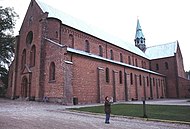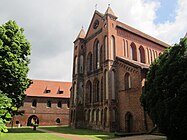
Romanesque architecture is an architectural style of medieval Europe that was predominant in the 11th and 12th centuries. The style eventually developed into the Gothic style with the shape of the arches providing a simple distinction: the Romanesque is characterized by semicircular arches, while the Gothic is marked by the pointed arches. The Romanesque emerged nearly simultaneously in multiple countries ; its examples can be found across the continent, making it the first pan-European architectural style since Imperial Roman architecture. Similarly to Gothic, the name of the style was transferred onto the contemporary Romanesque art.

Brandenburg an der Havel is a town in Brandenburg, Germany, which served as the capital of the Margraviate of Brandenburg until it was replaced by Berlin in 1417.
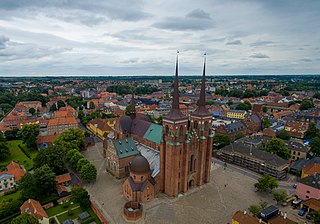
Roskilde Cathedral, in the city of Roskilde on the island of Zealand (Sjælland) in eastern Denmark, is a cathedral of the Lutheran Church of Denmark.

Brick Gothic is a specific style of Gothic architecture common in Northeast and Central Europe especially in the regions in and around the Baltic Sea, which do not have resources of standing rock. The buildings are essentially built using bricks. Buildings classified as Brick Gothic are found in Belgium, Netherlands, Germany, Poland, Lithuania, Latvia, Estonia, Kaliningrad, Switzerland, Denmark, Sweden and Finland.

Cistercian architecture is a style of architecture associated with the churches, monasteries and abbeys of the Roman Catholic Cistercian Order. It was heavily influenced by Bernard of Clairvaux, who believed that churches should avoid superfluous ornamentation so as not to distract from prayer. Although a few images of religious subjects were allowed, such as the crucifix, elaborate figures common in medieval churches were prohibited. Later abbeys were constructed in Renaissance and Baroque styles, which were more ornate by nature.

Kloster Lehnin, or just Lehnin, is a municipality in the German state of Brandenburg. It lies about 24 km (15 mi) west-south-west of Potsdam.

Lehnin Abbey is a former Cistercian monastery in Lehnin in Brandenburg, Germany. Founded in 1180 and secularized during the Protestant Reformation in 1542, it has accommodated the Luise-Henrietten-Stift, a Protestant deaconesses' house since 1911. The foundation of the monastery in the newly established Margraviate of Brandenburg was an important step in the high medieval German Ostsiedlung; today the extended Romanesque and Gothic brickstone buildings, largely restored in the 1870s, are a significant part of Brandenburg's cultural heritage.

Jerichow is a town on the east side of the river Elbe, in the District of Jerichower Land, of the state of Saxony-Anhalt in Germany. With about 270 square kilometres (100 sq mi), the municipality of Jerichow is one of the largest municipalities in area size in Germany.
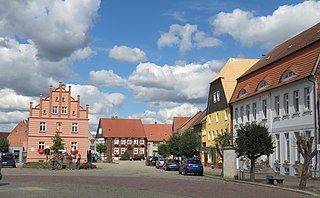
Werben (Elbe) is a town in the district of Stendal, in Saxony-Anhalt, Germany.

The architecture of Germany has a long, rich and diverse history. Every major European style from Roman to Postmodern is represented, including renowned examples of Carolingian, Romanesque, Gothic, Renaissance, Baroque, Classical, Modern and International Style architecture.
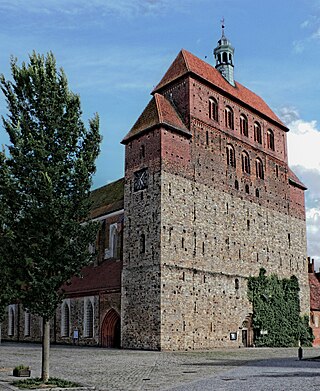
The Bishopric of Havelberg was a Roman Catholic diocese founded by King Otto I of Germany in 946, from 968 a suffragan to the Archbishops of Magedeburg. A Prince-bishopric (Hochstift) from 1151, Havelberg as a result of the Protestant Reformation was secularised and finally annexed by the margraves of Brandenburg in 1598.
Brick Renaissance is the Northern European continuation of brick architecture after Brick Romanesque and Brick Gothic. Although the term Brick Gothic is often used generally for all of this architecture, especially in regard to the Hanseatic cities of the Baltic, the stylistic changes that led to the end of Gothic architecture did reach Northern Germany and northern Europe with delay, leading to the adoption of Renaissance elements into brick building. Nonetheless, it is very difficult for non-experts to distinguish transitional phases or early Brick Renaissance, as the style maintained many typical features of Brick Gothic, such as stepped gables. A clearer distinction only developed at the transition to Baroque architecture. In Lübeck, for example, Brick Renaissance is clearly recognisable in buildings equipped with terracotta reliefs by the artist Statius von Düren, who was also active at Schwerin and Wismar (Fürstenhof).

Romano-Gothic is a term, rarely used in writing in English, for an architectural style, part of Early Gothic architecture, which evolved in Europe in the 12th century from the Romanesque style, and was an early style in Gothic architecture. In England "Early English Gothic" remains the usual term. The style is characterized by rounded and pointed arches on a vertical plane. Flying buttresses were used, but are mainly undecorated. Romanesque buttresses were also used. Romano-Gothic began to use the decorative elements of Gothic architecture, but not the constructional principles of more fully Gothic buildings. However, the walls did start to become thinner by using some pointed arches and ribbed vaults to distribute weight more evenly.
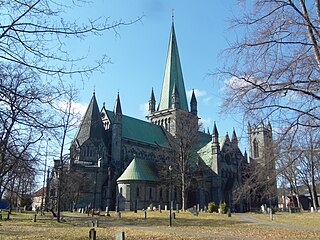
Church building in Norway began when Christianity was established there around the year 1000. The first buildings may have been post churches erected in the 10th or 11th century, but the evidence is inconclusive. For instance under Urnes Stave Church and Lom Stave Church there are traces of older post churches. Post churches were later replaced by the more durable stave churches. About 1,300 churches were built during the 12th and 13th centuries in what was Norway's first building boom. A total of about 3,000 churches have been built in Norway, although nearly half of them have perished. From 1620 systematic records and accounts were kept although sources prior to 1620 are fragmented. Evidence about early and medieval churches is partly archaeological. The "long church" is the most common type of church in Norway. There are about 1620 buildings recognized as churches affiliated with the Church of Norway. In addition, there are a number of gospel halls belonging to the lay movement affiliated with the Church of Norway as well as churches belonging to other Christian bodies. Until the 20th century, most churches were built from wood. 220 buildings are protected by law, and an additional 765 are listed as valuable cultural heritage.

Gothic architecture is a style of architecture that flourished during the high and late medieval period. It evolved from Romanesque architecture and was succeeded by Renaissance architecture.
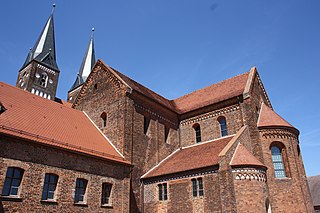
The Jerichow Monastery is a former Premonstratensian monastery located in the northern outskirts of Jerichow, near the shores of the Elbe River, in the state of Saxony-Anhalt of Germany.

The Gothic style of architecture was strongly influenced by the Romanesque architecture which preceded it. Why the Gothic style emerged from Romanesque, and what the key influences on its development were, is a difficult problem for which there is a lack of concrete evidence because medieval Gothic architecture was not accompanied by contemporary written theory, in contrast to the 'Renaissance' and its treatises. A number of contrasting theories on the origins of Gothic have been advanced: for example, that Gothic emerged organically as a 'rationalist' answer to structural challenges; that Gothic was informed by the methods of medieval Scholastic philosophy; that Gothic was an attempt to imitate heaven and the light referred to in various Biblical passages such as Revelation; that Gothic was 'medieval modernism' deliberately rejecting the 'historicist' forms of classical architecture. Beyond specific theories, the style was also shaped by the specific geographical, political, religious and cultural context of Europe in the 12th century onwards.

The St. Peter and Paul cathedral is the largest medieval church in Brandenburg an der Havel, Brandenburg, Germany. Construction began in 1165 as a Romanesque Saalkirche. It was expanded several times to a three-aisled Brick Gothic basilica. The cathedral is commonly designated “the cradle of the Mark Brandenburg” for its historic significance. The patron saints are Peter and Paul.







